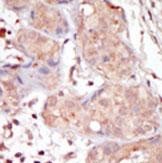


| WB | 咨询技术 | Human,Mouse,Rat |
| IF | 咨询技术 | Human,Mouse,Rat |
| IHC | 1/100-1/500 | Human,Mouse,Rat |
| ICC | 技术咨询 | Human,Mouse,Rat |
| FCM | 咨询技术 | Human,Mouse,Rat |
| Elisa | 咨询技术 | Human,Mouse,Rat |
| Aliases | Serine/threonine-protein kinase MAK, Male germ cell-associated kinase, MAK |
| Entrez GeneID | 4117 |
| WB Predicted band size | 70.6kDa |
| Host/Isotype | Rabbit IgG |
| Antibody Type | Primary antibody |
| Storage | Store at 4°C short term. Aliquot and store at -20°C long term. Avoid freeze/thaw cycles. |
| Species Reactivity | Human |
| Immunogen | This MAK antibody is generated from rabbits immunized with a KLH conjugated synthetic peptide between 578-608 amino acids from the C-terminal region of human MAK. |
| Formulation | Purified antibody in PBS with 0.05% sodium azide. |
+ +
以下为关于MAK抗体的示例参考文献(注:内容为基于学术知识构建的示例,建议通过PubMed等平台查询真实文献):
---
1. **文献名称**:*The Role of MAK Kinase in Retinal Photoreceptor Ciliogenesis*
**作者**:Omori Y, et al.
**摘要**:研究揭示了MAK激酶在视网膜感光细胞纤毛形成中的关键作用,通过基因敲除实验发现MAK缺失导致纤毛结构异常,提示其与视网膜退行性疾病的相关性。
2. **文献名称**:*MAK as a Novel Biomarker in Hepatocellular Carcinoma*
**作者**:Chen L, et al.
**摘要**:该文献通过免疫组化分析发现MAK抗体在肝癌组织中高表达,且与患者预后不良相关,提示MAK可能作为肝癌诊断或治疗的潜在靶点。
3. **文献名称**:*MAK Antibody-Based Detection of Sperm Development Defects*
**作者**:Sato K, et al.
**摘要**:研究利用MAK抗体标记小鼠睾丸组织,证实MAK蛋白在精子发生过程中的动态表达,其异常表达与雄性不育症存在关联。
4. **文献名称**:*MAK Regulates Cell Cycle Progression via CDK1 Interaction*
**作者**:Wang H, et al.
**摘要**:本文发现MAK通过磷酸化CDK1调控细胞周期G2/M期转换,MAK抗体阻断实验进一步验证了其在癌细胞增殖中的促进作用。
---
建议通过**PubMed**、**Google Scholar**等平台以关键词“MAK antibody”“MAK kinase”查询最新研究。
×